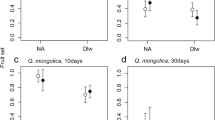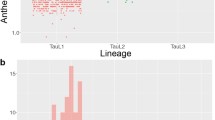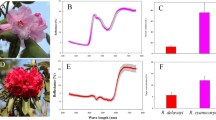Abstract
It is of critical importance for our understanding of speciation process to determine the forms of reproductive isolation and their relative importance in species divergence. Oryza nivara and O. rufipogon are direct ancestors of Asian cultivated rice and a progenitor-daughter species pair. Investigating the reproductive isolation between them provides insights into plant speciation and helps understanding of the rice domestication. Here, we quantitatively measured the major components of reproductive isolation between the two species based on common garden and crossing experiments for three pairs of sympatric populations in Nepal, Cambodia and Laos. We revealed significant differences in the flowering times between species pairs, with O. nivara flowering much earlier than O. rufipogon. A very weak reduction in seed set but no reduction in F1 viability and fertility were detected for the crosses between species relative to those within species. Moreover, we detected asymmetrical compatibility between species and found that emasculation significantly decreased pollination success in O. nivara but not in O. rufipogon. Our study demonstrates that the divergence between O. nivara and O. rufipogon is maintained almost entirely by the difference in flowering times and suggests that differential flowering times contribute to both habitat preferences and reproductive isolation between species.
Similar content being viewed by others
References
Abbott, R.J. (2017). Plant speciation across environmental gradients and the occurrence and nature of hybrid zones. J Syst Evol 55, 238–258.
Baack, E., Melo, M.C., Rieseberg, L.H., and Ortiz-Barrientos, D. (2015). The origins of reproductive isolation in plants. New Phytol 207, 968–984.
Banaticla-Hilario, M.C.N., McNally, K.L., van den Berg, R.G., and Sackville Hamilton, N.R. (2013). Crossability patterns within and among Oryza series Sativae species from Asia and Australia. Genet Resour Crop Evol 60, 1899–1914.
Barbier, P. (1989). Genetic variation and ecotypic differentiation in the wild rice species Oryza rufipogon. I. Population differentiation in life-history traits and isozymic loci. Jpn J Genet 64, 259–271.
Briscoe Runquist, R.D., Chu, E., Iverson, J.L., Kopp, J.C., and Moeller, D. A. (2014). Rapid evolution of reproductive isolation between incipient outcrossing and selfing Clarkia species. Evolution 68, 2885–2900.
Brys, R., Vanden Broeck, A., Mergeay, J., and Jacquemyn, H. (2014). The contribution of mating system variation to reproductive isolation in two closely related Centaurium species (Gentianaceae) with a generalized flower morphology. Evolution 68, 1281–1293.
Burton, R.S., Pereira, R.J., and Barreto, F.S. (2013). Cytonuclear genomic interactions and hybrid breakdown. Annu Rev Ecol Evol Syst 44, 281–302.
Cai, H.W., Wang, X.K., and Morishima H. (2004). Comparison of population genetic structures of common wild rice (Oryza rufipogon Griff.), as revealed by analyses of quantitative traits, allozymes, and RFLPs. Heredity 92, 409–417.
Cai, Z., Zhou, L., Ren, N.N., Xu, X., Liu, R., Huang, L., Zheng, X.M., Meng, Q.L., Du, Y.S., Wang, M.X., et al. (2019). Parallel speciation of wild rice associated with habitat shifts. Mol Biol Evol 36, 875–889.
Chu, Y.E., Morishima, H., and Oka, H.I. (1969). Reproductive barriers distributed in cultivated rice species and their wild relatives. Jpn J Genet 44, 207–223.
Coyne, J.A., and Orr, H.A. (2004). Speciation (Sunderland: Sinauer Associates, Inc.).
Delph, L.F. (2019). Pollen competition is the mechanism underlying a variety of evolutionary phenomena in dioecious plants. New Phytol 224, 1075–1079.
Grillo, M.A., Li, C., Fowlkes, A.M., Briggeman, T.M., Zhou, A., Schemske, D.W., and Sang, T. (2009). Genetic architecture for the adaptive origin of annual wild rice, Oryza nivara. Evolution 63, 870–883.
Hey, J. (2006). Recent advances in assessing gene flow between diverging populations and species. Curr Opin Genets Dev 16, 592–596.
Hipperson, H., Dunning, L.T., Baker, W.J., Butlin, R.K., Hutton, I., Papadopulos, A.S.T., Smadja, C.M., Wilson, T.C., Devaux, C., and Savolainen, V. (2016). Ecological speciation in sympatric palms: 2. Pre-and post-zygotic isolation. J Evol Biol 29, 2143–2156.
Huang, P., and Schaal, B.A. (2012). Association between the geographic distribution during the last glacial maximum of Asian wild rice, Oryza rufipogon (Poaceae), and its current genetic variation. Am J Bot 99, 1866–1874.
Kuroda, Y., Sato, Y.I., Bounphanousay, C., Kono, Y., and Tanaka, K. (2007). Genetic structure of three Oryza AA genome species (O. rufipogon, O. nivara and O. sativa) as assessed by SSR analysis on the Vientiane Plain of Laos. Conserv Genet 8, 149–158.
Li, G., Jin, J., Zhou, Y., Bai, X., Mao, D., Tan, C., Wang, G., and Ouyang, Y. (2019). Genome-wide dissection of segregation distortion using multiple inter-subspecific crosses in rice. Sci China Life Sci 62, 507–516.
Liu, R., Zheng, X.M., Zhou, L., Zhou, H.F., and Ge, S. (2015). Population genetic structure of Oryza rufipogon and Oryza nivara: implications for the origin of O. nivara. Mol Ecol 24, 5211–5228.
Lowry, D.B., Modliszewski, J.L., Wright, K.M., Wu, C.A., and Willis, J.H. (2008). The strength and genetic basis of reproductive isolating barriers in flowering plants. Phil Trans R Soc B 363, 3009–3021.
Lu, B.R. (1996). A report on collecting of wild Oryza species in Lao PDR and Cambodia. (Los Banos: International Rice Research Institute).
Lu, B.R. (1998). A report on NARC-IRRI cooperative collection of wild Oryza species in Nepal. (Los Banos: International Rice Research Institute).
Martin, H., Touzet, P., Dufay, M., Godé, C., Schmitt, E., Lahiani, E., Delph, L.F., and Van Rossum, F. (2017). Lineages of Silene nutans developed rapid, strong, asymmetric postzygotic reproductive isolation in allopatry. Evolution 71, 1519–1531.
Martin, N.H., and Willis, J.H. (2007). Ecological divergence associated with mating system causes nearly complete reproductive isolation between sympatric Mimulus species. Evolution 61, 68–82.
Mayr, E. (1942). Systematics and the origin of species (New York: Columbia University Press).
Morishima, H. (1985). Habitat, genetic structure and dynamics of perennial and annual populations of the Asian wild rice Oryza perennis. In Genetic Differentiation and Dispersal in Plants, P. Jacquard, G. Heim, and J. Antonovics, eds. (Berlin: Springe-Verlag).
Morishima, H., Chang, W.T., and Oka, H.I. (1961). Directions of differentiation in populations of wild rice, Oryza perennis and O. sativa f. spontanea. Evolution 15, 326–339.
Morishima, H., Sano, Y., and Oka, H.I. (1984). Differentiation of perennial and annual types due to habitat conditions in the wild rice Oryza perennis. Pl Syst Evol 144, 119–135.
Naredo, M.E.B., Juliano, A.B., Lu, B.R., and Jackson, M.T. (1997). Hybridization of AA genome rice species from Asia and Australia I. Genet Resources Crop Evol 44, 17–23.
Naredo, M.E.B., Juliano, A.B., Lu, B.R., and Jackson, M.T. (1998). Taxonomic status of Oryza glumaepatula Steud. Genet Resources Crop Evol 45, 205–214.
Nezu, M., Katayama, T.C., and Kihara, H. (1960). Genetic study of the genus Oryza. I. Crossability and chromosomal affinity among 17 species. Rep Kihara Inst biol Res, 1–11.
Nosil, P. (2012). Ecological Speciation (Oxford: Oxford University Press).
Oka, H.I., and Morishima, H. (1967). Variations in the breeding systems of a wild rice, Oryza perennis. Evolution 21, 249–258.
Ostevik, K.L., Andrew, R.L., Otto, S.P., and Rieseberg, L.H. (2016). Multiple reproductive barriers separate recently diverged sunflower ecotypes. Evolution 70, 2322–2335.
Pereira, M.R., Ledent, A., Mardulyn, P., Zartman, C.E., and Vanderpoorten, A. (2019). Maintenance of genetic and morphological identity in two sibling Syrrhopodon species (Calymperaceae, Bryopsida) despite extensive introgression. J Syst Evol 57, 395–403.
Pianka, E.R. (1970). On r- and K-Selection. Am Natist 104, 592–597.
Ramsey, J., Bradshaw, H.D., and Schemske, D.W. (2003). Components of reproductive isolation between the monkey flowers Mimulus lewisii and M. cardinalis (Phrymaceae). Evolution 57, 1520–1534.
Ren, N.N. (2019). Studies on the phenotypic variaiton and its evolutioanry significance of wild rice Oryza rufipogon and O. nivara. (Beijing: Institute of Botany, the Chinese Academy of Sciences).
Richards, T.J., Walter, G.M., McGuigan, K., and Ortiz-Barrientos, D. (2016). Divergent natural selection drives the evolution of reproductive isolation in an Australian wildflower. Evolution 70, 1993–2003.
Rieseberg, L.H., and Carney, S.E. (1998). Plant hybridization. New Phytol 140, 599–624.
Samal, R., Roy, P.S., Sahoo, A., Kar, M.K., Patra, B.C., Marndi, B.C., and Gundimeda, J.N.R. (2018). Morphological and molecular dissection of wild rices from eastern India suggests distinct speciation between O. rufipogon and O. nivara populations. Sci Rep 8, 2773.
Sang, T., and Ge, S. (2007a). Genetics and phylogenetics of rice domestication. Curr Opin Genets Dev 17, 533–538.
Sang, T., and Ge, S. (2007b). The puzzle of rice domestication. J Integrative Plant Biol 49, 760–768.
Seehausen, O., Butlin, R.K., Keller, I., Wagner, C.E., Boughman, J.W., Hohenlohe, P.A., Peichel, C.L., Saetre, G.P., Bank, C., Brännström, A., et al. (2014). Genomics and the origin of species. Nat Rev Genet 15, 176–192.
Sharma, S.D., and Shastry, S.V.S. (1965). Taxonomic studies in genus Oryza L. III. O. rufipogon Griff. sensu stricto and O. nivara Sharma et Shastry nom. nov. Indian J Genet PL BR 25, 157–167.
Sobel, J.M., and Chen, G.F. (2014). Unification of methods for estimating the strength of reproductive isolation. Evolution 68, 1511–1522.
Sobel, J.M., Chen, G.F., Watt, L.R., and Schemske, D.W. (2010). The biology of speciation. Evolution 64, 295–315.
Sobel, J.M., and Streisfeld, M.A. (2015). Strong premating reproductive isolation drives incipient speciation in Mimulus aurantiacus. Evolution 69, 447–461.
Suni, S.S., and Hopkins, R. (2018). The relationship between postmating reproductive isolation and reinforcement in Phlox. Evolution 72, 1387–1398.
Tiffin, P., Olson, M.S., and Moyle, L.C. (2001). Asymmetrical crossing barriers in angiosperms. Proc R Soc Lond B 268, 861–867.
Vaughan, D.A. (1989). The genus Oryza L. current status of taxonomy. IRRI Res Pap Ser 138, 21.
Vaughan, D.A., Lu, B.R., and Tomooka, N. (2008). The evolving story of rice evolution. Plant Sci 174, 394–408.
Via, S. (2009). Natural selection in action during speciation. Proc Natl Acad Sci USA 106, 9939–9946.
Widmer, A., Lexer, C., and Cozzolino, S. (2009). Evolution of reproductive isolation in plants. Heredity 102, 31–38.
Xie, Y., Shen, R., Chen, L., and Liu, Y.G. (2019). Molecular mechanisms of hybrid sterility in rice. Sci China Life Sci 62, 737–743.
Zheng, X.M., and Ge, S. (2010). Ecological divergence in the presence of gene flow in two closely related Oryza species (Oryza rufipogon and O. nivara). Mol Ecol 19, 2439–2454.
Zhou, H.F., Zheng, X.M., Wei, R.X., Second, G., Vaughan, D.A., and Ge, S. (2008). Contrasting population genetic structure and gene flow between Oryza rufipogon and Oryza nivara. Theor Appl Genet 117, 1181–1189.
Zhou, L. (2019). Studies on flowering time variation and Hd1 gene in wild rice Oryza rufipogon and O. nivara. (Beijing: Institute of Botany, the Chinese Academy of Sciences).
Acknowledgements
We thank Bao-Rong Lu, Wen-Li Chen, Cheng-Bin Chen, Hua-Zhong Zeng, Yun-Tao Liang for their helps in the field surveys and common garden experiment. We also thank the International Rice Research Institute (Los Banos, Philippines) for providing seed samples. This work was supported by the National Natural Science Foundation of China (91731301), the grants from the Chinese Academy of Sciences (XDB31000000, XDA08020103) and CAS/SAFEA International Partnership Program for Creative Research Teams.
Author information
Authors and Affiliations
Corresponding author
Ethics declarations
The author(s) declare that they have no conflict of interest.
Additional information
Supporting Information
Figure S1 Variation of first heading of three pairs of O. rufipogon (blue) and O. nivara (red) populations from 2011 to 2013 in the common garden experiment. Boxes and horizontal bars represent the central 50% and median of heading dates, respectively. Dots represent the outliers beyond 1.5 times the interquartile range. Numbers of individuals (O. rufipogon/O. nivara) that were observed are in parentheses.
Table S1 Information on the O. rufipogon and O. nivara populations used in this study. N, number of individuals sampled
Table S2 Flowering phenology of three pairs of O. rufipogon and O. nivara populations in the common garden expriment in three consecutive years in Guanxi, China
Table S3 Summary of different types of crosses for six O. rufipogon and O. nivara populations
Table S4 Seed set of the self-pollinations with and without emasculation. em, emasculation; ns, no significance; **, P < 0.01; ***, P < 0.001
Table S5 Significant tests for the seed sets between different types of crosses. ns, no significance; ***, P<0.001
Table S6 Significant tests for the viability of F1 hybrids between different types of crosses. Level of significances is listed in the following order: germination rate, seedling survival rate and total survival rate. ns, no significance; *, P<0.05; ***, P<0.001
Table S7 Viability and fertility of the F1 hybrids between pairs of species populations. *, this index is the absolute contribution (AC) of germination rate (AC1) and seedling survival (AC2) to the total isolation, and zero represents a higher fitness of F1 hybrids relative to their parents
Table S8 Design of crossing experiments. Population codes are the same to those in Table S1 in Supporting Information. Numbers of crosses are in the parentheses
The supporting information is available online at http://life.scichina.com and https://link.springer.com. The supporting materials are published as submitted, without typesetting or editing. The responsibility for scientific accuracy and content remains entirely with the authors.
Electronic Supplementary Material
Rights and permissions
About this article
Cite this article
Xu, X., Meng, QL., Geng, MF. et al. Divergence in flowering time is a major component contributing to reproductive isolation between two wild rice species (Oryza rufipogon and O. nivara). Sci. China Life Sci. 63, 1714–1724 (2020). https://doi.org/10.1007/s11427-019-1678-6
Received:
Accepted:
Published:
Issue Date:
DOI: https://doi.org/10.1007/s11427-019-1678-6




